"Far and Away" Production Notes |
Read more at in70mm.com The 70mm Newsletter |
| Written by: Universal Pictures, 1992 | Date: 22.06.2024 |
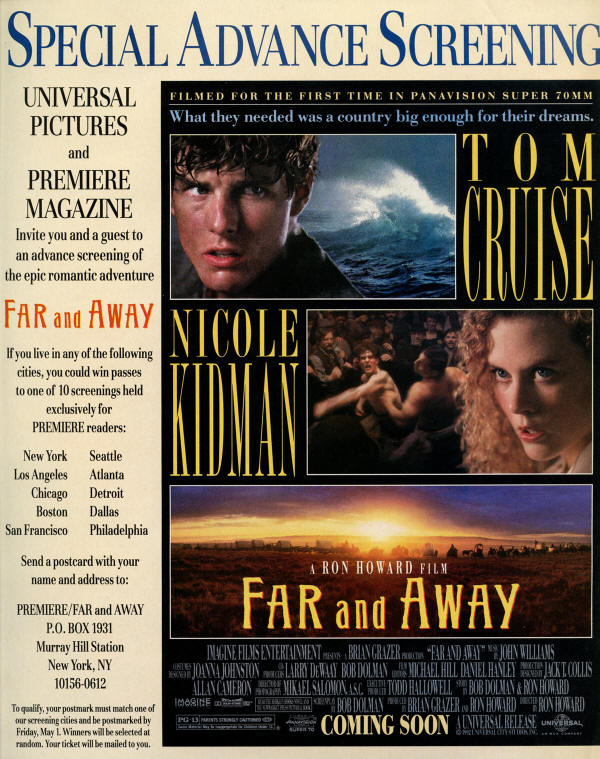
For two young people, Joseph Donelly and Shannon Christie, there was no
greater prize imaginable than the chance to possess their own land. It was a
dream that ran like fire in their blood.
Although both Shannon and Joseph were born
in Ireland, they came from entirely different worlds. "They could never have
accomplished the things they did in Ireland," says screenwriter Bob Dolman.
"They were both prisoners of the class system. Joseph was a tenant farmer
kept in poverty by the landed classes, and Shannon grew up in a world where
no woman--however well-born--could ever hope to control her own destiny." |
More in 70mm reading: A Conversation with Cinematographer and Academy Award nominee Mikael Salomon, DFF, ASC Imagine Films Entertainment Presents "Far And Away" “Far and Away”: The 70mm Engagements DoP Mikael Salomon's introduction to "Far and Away" Panavison Large Format Motion Picture Systems Motion pictures photographed in Super Panavision 70 & Panavision System 65 “Far and Away”: The 70mm Engagements in70mm.com's Library Presented on the big screen in 7OMM Peripheral Vision, Scopes, Dimensions and Panoramas |
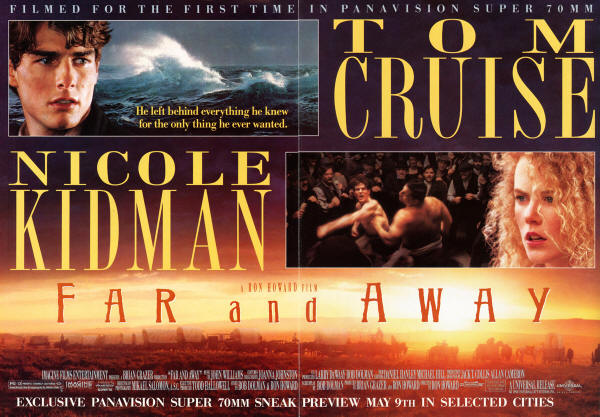 In the end, however, the ambition that brought Shannon and Joseph to America
draws them inevitably to the Oklahoma territory. As they discover, the race
they run is not always to the swift; but, through enterprise, determination
--and a few miracles--they earn at last the chance to fulfill their dreams. In the end, however, the ambition that brought Shannon and Joseph to America
draws them inevitably to the Oklahoma territory. As they discover, the race
they run is not always to the swift; but, through enterprise, determination
--and a few miracles--they earn at last the chance to fulfill their dreams."Far and Away" is the first feature film ever to be photographed with the new Panavision Super 70 camera equipment, using 65mm stock recently developed by Eastman Kodak. The result is a visual experience that matches the breadth and scope of "Far and Away," whose sweeping narrative spans some of the most beautiful landscapes in the world: from the haunting west coast of Ireland to the crowded streets of Boston to the majestic plains of the American West. Although Ron Howard, Bob Dolman and Brian Grazer have been developing "Far and Away" for eight years, the inspiration for the project goes back much further, to the early days of Howard's childhood.
Over the years, Howard developed an avid interest in stories of his family's
immigrant past. A product of the American melting pot, Howard can trace his
bloodlines back to Dutch, English, German and even Cherokee Indian roots.
But it was the romance of his Irish ancestors that continued to sway his
imagination over the years.
In 1983, Howard directed a TV pilot written by Bob Dolman. Both of them
confessed a dream to make a film about Ireland. One night, Howard was at a
concert of the traditional Irish group The Chieftains (whose music can be
heard in "Far and Away"). He was touched by a tragic song about a couple in
love, torn apart when one of them departed for America.
|
|
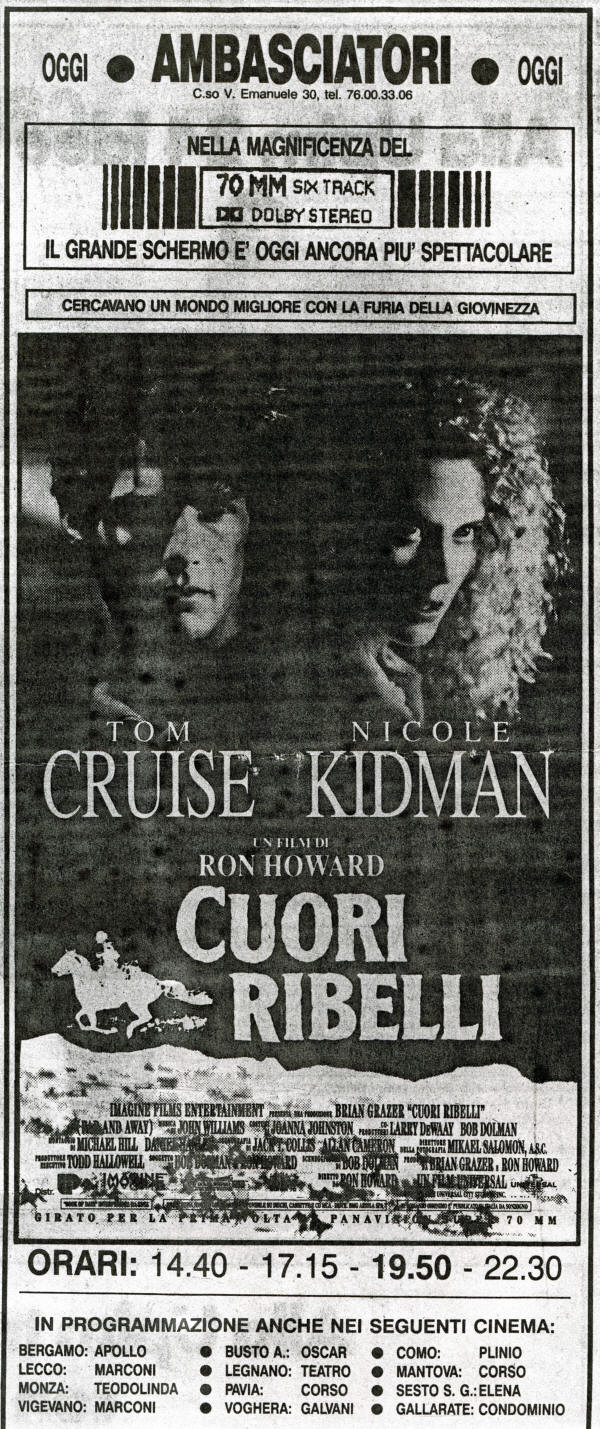 Italian
advertising Italian
advertisingHoward likewise developed a keen sympathy for his human subjects. "It's easy to be daunted by the hugeness of the events that are covered in this film. That's why we wanted to keep the focus on the human level. The people who immigrated to this country and settled the West didn't always start out as remarkable individuals--the adventures they lived made them remarkable." Howard's father Rance, who plays a small role in the film, is impressed by how his son has translated their family's real-life stories to the screen: "My grandfather was like Joseph--a man of the land. My grandmother was more like Shannon--worldly and sophisticated." The script for "Far and Away" was developed over the course of eight years. These were eventful years for Ron Howard: his career as a director of feature films, launched by "Grand Theft Auto," "Night Shift" and "Splash," helped lead to the creation of Imagine Films Entertainment, an independent production company Howard co-founded with Brian Grazer, whose career as a producer has included such films as "Splash," "Parenthood" and last year's hit "My Girl." Active pre-production for "Far and Away" began even as Howard and Grazer's last collaboration, the Imagine/ Universal hit "Backdraft," was in principal photography. Casting the film's lead roles required a turn of events that was no less serendipitous than Joseph and Shannon's voyage to America.
As it happened, the script reached Cruise in 1989, at a time when he was
already looking for a strong romantic vehicle. Cruise felt an immediate
kinship with the brash, enterprising Joseph Donelly, and expressed his
enthusiasm to Howard during a visit to the set of "Backdraft."
As in all his feature films, Cruise prepared for the role of Joseph with a
singleminded passion for detail: in "Taps," he worked out for months to beef
himself up for his role as a hyper-aggressive military cadet; in
“Born on the Fourth of July”, he immersed himself in the world of handicapped veteran
Ron Kovic, painstakingly learning the hardships of maneuvering in and out of
wheelchairs. "As soon as we took off, there was a cloud of dust, and I couldn't see a thing--all I could hear was the echo of the stampede in my ears. For a moment, I was completely caught up in what was happening. I began to sense what a monumental event the real land rush actually was."
Many of these scenes were realized in Ireland, where production moved after
the completion of the land rush sequences. The spectacular house and gardens
of the Kilruddy Estate, built in 1651, served as the home of Shannon
Christie's family (the house was built by the 2nd Earl of Meath--like the
Christies, a Protestant landlord).
In many ways, the conclusion of principal photography in Dingle has brought
Ron Howard back to his beginnings: in his first glimpse of Ireland as a
child, the inspiration for "Far and Away" was sown. Years later, scouting
locations over Ireland by helicopter, Howard was filled with a deep sense of
nostalgia.
|
|
About the Cast |
|
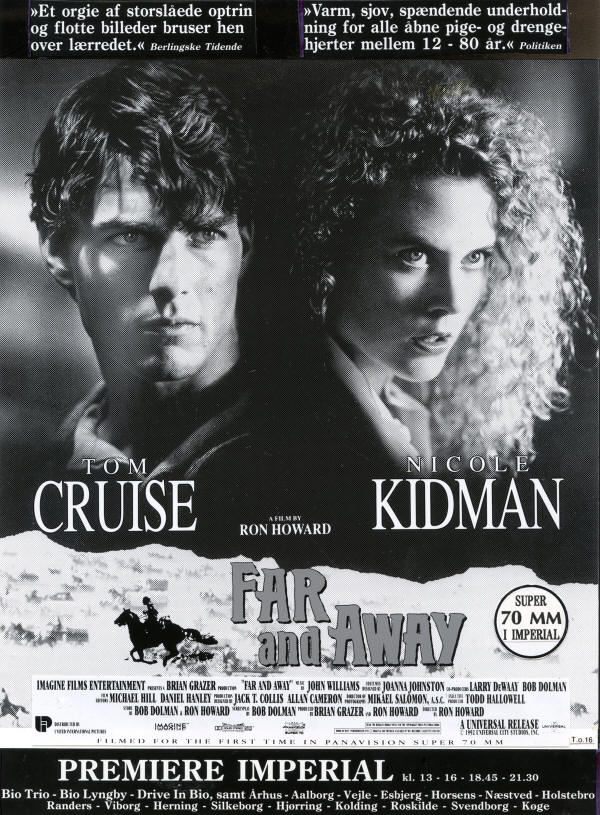 Danish
Advertising Danish
AdvertisingOver the past decade, TOM CRUISE (Joseph) has emerged as one of the most accomplished actors of our time, one whose performances have brought him both critical and public acclaim--earning him a Golden Globe Award, an Academy Award nomination and a People's Choice Award for Best Actor for his haunting portrayal of war-scarred veteran Ron Kovic in "Born on The Fourth of July." In less than a decade, his films have grossed more than $1.5 billion worldwide. Cruise first attracted attention as a headstrong young military cadet in 1981's "Taps." Two years later, his starring role in "Risky Business" demonstrated his ability to command a wide audience. His portrayal of Maverick in the highest grossing film of 1986, “Top Gun”, created a nationwide sensation. In 1990, Cruise's film “Days of Thunder”--his first on-screen collaboration with "Far and Away" co-star Nicole Kidman--became the highest-grossing race-car film in cinematic history, with a cumulative gross of $195 million worldwide. Cruise has earned the accolades of peers and public alike for his collaborations with many of the entertainment profession's most distinguished filmmakers: with Paul Newman in Martin Scorsese's “The Color of Money”, opposite Dustin Hoffman in Barry Levinson's Academy Award-winning film "Rain Man," and with five-time Academy Award winner Oliver Stone in "Born on the Fourth of July"--a performance which earned Cruise an Academy Award nomination for Best Actor. Nicole Kidman One of Australia's best-known young performers, Nicole Kidman first came to the attention of American audiences with her critically acclaimed performance in the psychological thriller "Dead Calm." She co-starred with Tom Cruise in the 1990 international box-office hit, "Days of Thunder." This year, she was featured opposite Bruce Willis and Dustin Hoffman in the screen version of E. L. Doctorow's Pulitzer prize-winning novel, "Billy Bathgate," for which she received a Golden Globe nomination. Born in Hawaii, Kidman spent her childhood in Australia and began a successful film career at the age of fourteen in "Bush Christmas." In 1985, when she was only seventeen, Kidman became an overnight sensation in Australia for her award-winning performance in the acclaimed mini-series, "Vietnam." Between films, she continued to hone her craft at the St. Martin's Youth Theatre in Melbourne, the Australian Theatre for Young People in Sydney and the Philip Street Theatre, where she learned voice, production and theatre history. Kidman won her plum role in "Dead Calm" over a pool of many of the film community's most established actresses. She received special notice both for her technical virtuosity and her visceral emotional presence. Thomas Gibson Thomas Gibson, who plays Stephen Chase, Shannon's fiance, is a newcomer to feature films. Having graduated from the Juilliard School's drama division in 1985, Gibson has spent the last seven years working mostly on New York's theatrical stages on and off Broadway. In productions by the New York Shakespeare Festival, he has starred in "Henry IV" (Parts I and II) as Prince Hal, as Malcolm in "Macbeth" with Raul Julia, as Count Orsino in "Twelfth Night" and as Proteus in "The Two Gentlemen of Verona" with Elizabeth McGovern. Gibson has performed in premieres of many new plays by playwrights David Hare, Howard Brenton, Romulus Linney, and Anna Cascio and is active in theater groups committed to the development of new plays. Audiences may also recognize Gibson from his television work. Daytime appearances include stints as Sam Fowler on "Another World" and as Derek Mason on "As The World Turns." Gibson also appeared in the mini-series "The Kennedys of Massachusetts" and the mini-series version of Gore Vidal's, "Lincoln," starring Sam Waterson and Mary Tyler Moore. Robert Prosky ROBERT PROSKY (Daniel Christie) plays Shannon's father, an eccentric but essentially kindly landlord who is not always aware of what is being done in his name. Christie is sympathetic to Joseph at heart, and endeavors to understand his daughter's restlessness as well. Prosky is best known for his roles on screen and as Sgt. Stanislaus Jablonski on "Hill St. Blues," though he has spent most of his professional career on stage. Prosky has two Tony Award nominations for his work in "Glengarry Glen Ross" and "A Walk in the Woods." Other Broadway credits include "Moonchildren," "A View From the Bridge," "Pale Horse, Pale Rider" and "Arms and the Man." Prosky has spent over 25 years at the Arena Stage in Washington, D.C. where he has taught acting and appeared in over 150 plays: as Willy Loman in "Death of a Salesman," "Twelfth Night," "An Enemy of the People" and the title role in "Galileo." In the company's tour of the Soviet Union, he played the stage manager on "Our Town," which gave him the opportunity to reprise the first role he had at age 15 in a high school production. In 1980 director Michael Mann cast him as the intimidating mobster in "Thief" with James Caan and suddenly Prosky was in demand for the big screen. Other film credits include "Outrageous Fortune," Big Shots," "The Lords of Discipline," "Christine," "Monsignor," "The Keep," "Hanky Panky," "The Natural," "The Great Outdoors," "Things Change" and "Broadcast News." Barbara Babcock BARBARA BABCOCK (Nora Christie) appears as Shannon's mother, a model of decorum who can't quite understand why her daughter feels trapped in such luxurious surroundings. Babcock is one of the industry's most versatile actresses. She earned an Emmy Award for Best Actress for her memorable role as the lusty Grace on "Hill St. Blues." She has also been a series regular on "The Law and Harry McGraw" and "The Four Seasons." She has guest starred on scores of television programs, including "China Beach," "Golden Girls," "Murder, She Wrote," "Wings" and the original "Star Trek" series. On screen, she co-starred in "Heart of Dixie," "Happy Together," "That Was Then, This Is Now," "The Lords of Discipline," "The Black Marble," "Bang The Drum Slowly," "Day of The Evil Gun," "Gypsy Moths" and "Heaven With A Gun." On stage, Babcock recently starred in "Passion" at the Mark Taper Theatre, with Mildred Natwick in "The Torchbearers," the noted off-Broadway production of "Nature of The Crime" and the Los Angeles productions of "Charley's Aunt" and "Auntie Mame." Colm Meaney COLM MEANEY (Kelly) is featured as the Boston ward boss who takes in Joseph and Shannon when they arrive in Boston. A native of Dublin, Meaney made a sudden splash in films with his work in "Dick Tracy," "Come See The Paradise," "Die Hard II" and the Alan Parker film, "The Commitments." Forthcoming is his role in the remake of "Last of The Mohicans." He currently can be seen as O'Brien on television's "Star Trek: The Next Generation." |
|
About the Filmmakers |
|
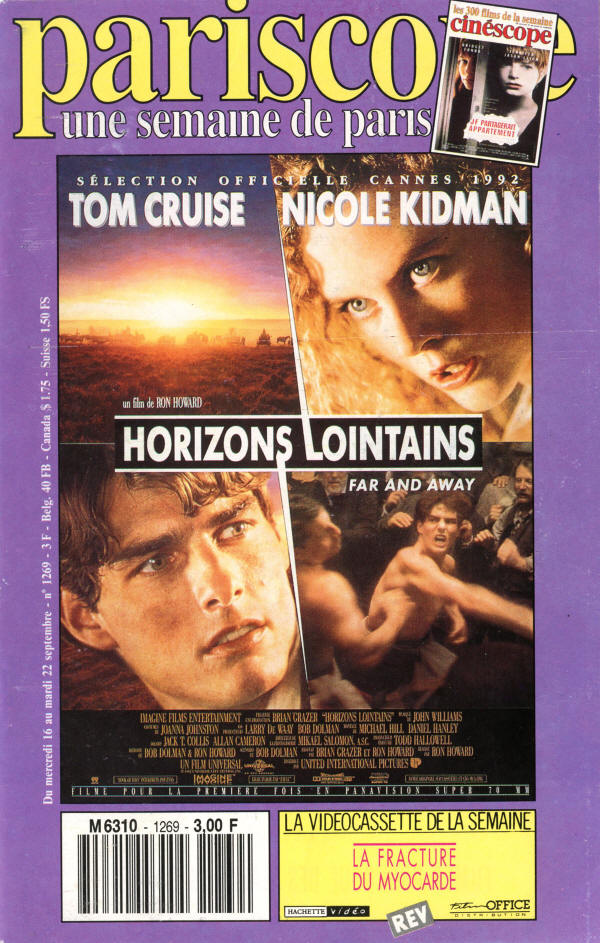 French
advertising from Paris French
advertising from ParisRon Howard During the development of "Far and Away," director Ron Howard was inspired by stories of his ancestors, especially those who--like Joseph and Shannon--took part in the Oklahoma land rush. One story in particular, however, illustrates one of Howard's favorite themes: the strange and often comic twists of fate that guide people to their destiny. "One of my great-grandfathers--the only one who didn't take part in the Cherokee Strip land rush--was thrown off a train near a small town out west," says Howard. "As it happened, he later became the mayor of that town, and one of its most prosperous citizens. But it wouldn't have happened if they hadn't thrown him off." "Much of the humor and excitement of 'Far and Away' is driven by these kinds of small miracles," says Howard. "It's romantic, emotional and even whimsical at times. It's the type of story that we all wish had happened in our family." Ron Howard has been involved with feature films and television programming as a writer, producer, actor and director for many years. Born in Duncan, Oklahoma, he made his acting debut at the age of 18 months in a Baltimore production of "The Seven Year Itch," and his first screen appearance in "The Journey," when he was four years old. As a child actor, he appeared in "The Music Man" and the long-running television series "The Andy Griffith Show." He also starred in the popular television series "Happy Days," and drew favorable reviews for his performances in "American Graffiti" and "The Shootist." Howard directed his first feature film, "Grand Theft Auto," in 1978, when he was 23 years old. This began a string of popular hits, ranging from domestic comedy to science-fiction/fantasy: "Night Shift," "Splash," "Cocoon," "Gun g Ho," "Willow" and, in 1989, "Parenthood." Last year he directed "Backdraft," which received four Academy Award nominations and was one of the highest-grossing films of the year. Together with Brian Grazer, he is a founder and chief executive officer of Imagine Films Entertainment, Inc., a public company that independently produces theatrical feature films. Since Imagine went public in 1986, Howard has served as executive producer for "No Man's Land," "Vibes" and "Clean and Sober." In 1989 Howard produced Imagine's "The 'burbs," starring Tom Hanks. Howard currently resides in Connecticut with his wife and four children. Brian Grazer Producer Brian Grazer was recently honored as NATO/Showiest '92 Producer of the Year. In addition to "Far and Away," he serves as producer on the upcoming Universal release "Housesitter," a romantic comedy starring Steve Martin and Goldie Hawn directed by Frank Oz, and "Boomerang," a comedy starring Eddie Murphy. Mr. Grazer also produced the recent sleeper hit "My Girl," starring Macaulay Culkin and Anna Chlumsky, as well as "Backdraft," "Kindergarten Cop," "The Doors" and "Parenthood." Co-chairman (with Ron Howard) and CEO of Imagine Films Entertainment, Inc., Grazer has established himself as a creative producer with a sharp eye for new talent. He has helped launch the film careers of such stars as Michael Keaton, Tom Hanks, Meg Ryan, Daryl Hannah, John Candy, Johnny Depp and, most recently, Anna Chlumsky. Grazer, whose keen sense of story earned him an Academy Award nomination for "Splash," has harnessed his talent for combining story with stars to produce three top-ten box office hits: "Parenthood," starring Steve Martin, "Spies Like Us," starring Chevy Chase and Dan Aykroyd, and "Splash," starring Tom Hanks and Daryl Hannah. Grazer's other films include "Clean and Sober" (Michael Keaton), "Night Shift" (Michael Keaton and Henry Winkler) and "Real Genius" (Val Kilmer). Bob Dolman BOB DOLMAN (Screenwriter/Co-producer) has been associated with Ron Howard since 1983, when Howard directed Dolman's NBC pilot "Little Shots." Soon after, they started discussing preliminary ideas for the project that would later become "Far and Away." In the meantime, Dolman wrote the film "Willow," directed by Howard in 1986, and was also a staff writer on "WKRP" and "SCTV." The last of these brought Dolman two Emmy Awards for writing. In 1988, Dolman conceived and produced the Showtime series "Poison." Todd Hallowell TODD HALLOWELL (Executive Producer) started his career as assistant art director (and photo double for Ron Howard) on Roger Corman's "Grand Theft Auto," Howard's directorial debut in 1977. He subsequently was an art director on "Back To The Future," "Down and Out in Beverly Hills," "Fletch," "Cloak and Dagger" and the pilot for "Miami Vice." He was also production designer for the films "Tough Guys," "Burglar," "Adventure in Babysitting," "The Dream Team," "Vital Signs" and "Parenthood." On "Backdraft" he served as second unit director and associate producer. He also was the second unit director on "Adventures in Babysitting" and directed the feature film "Love or Money" starring Timothy Daly. LARRY DE WAAY (Co-producer) served as co-producer for "Backdraft" and was executive producer on "The Hunt For Red October," "Next of Kin" and "Yentl," co-producer of "Hamburger Hill" and "Electric Dreams," and was the producer of "The Dogs of War." After serving as a location manager for such films as "The Russians Are Coming, The Russians Are Coming" and "Hallelujah Trail," DeWaay joined Norman Jewison's company in 1971 and worked as production supervisor for such films as "Fiddler on The Roof," "Jesus Christ Superstar," "Rollerball," "FIST" and "...And Justice For All." |
|
 Mikael Salomon Mikael SalomonMIKAEL SALOMON (Director of Photography) has, in less than five years in the United States, become one of the most respected and sought after cinematographers in the film industry. His reputation was further enhanced by his recent camera work on Ron Howard's "Backdraft." A native of Denmark, Salomon received an Academy Award nomination in 1990 for his work on "The Abyss." Other credits include, “Always” , “Arachnophobia”, "Torch Song Trilogy," "Zelly and Me" and the HBO movie, "The Man Who Broke 1000 Chains," for which he won an ACE Award. Starting his career as a camera assistant in Denmark, Salomon was the director of photography on his first feature at age 19. In addition to a short stint at a Danish film school, he was a cinematographer on over 40 films, including "Wolf at the Door," starring Donald Sutherland as Gaugin; "Flying Devil," for which he received a Danish Academy Award and "Early Spring," for which he won the Spanish award, Mejor Fotografia. Salomon also shot a British film in Yugoslavia called "Stealing Heaven." John Williams Over the last three decades, the name of JOHN WILLIAMS (Composer) has become virtually synonymous with motion picture music. His film career began in 1961 with the music for "The Secret Ways." In the early 1970's, he created gripping and suspenseful scores for popular "disaster" films such as “The Poseidon Adventure”, “Earthquake” and “The Towering Inferno”. A master of every genre and emotional nuance, Williams has composed many of the most familiar themes in movie history, including "Jaws" and “Star Wars” (both of which earned him Academy Awards for Best Original Score), “Close Encounters of the Third Kind”, "Dracula," "Superman," “E.T. - The Extra Terrestrial”, the “Raiders of the Lost Ark” trilogy, "The River" and "Born on the Fourth of July." For many years he also served as conductor of the Boston Pops Orchestra. Daniel Hanley And Michael Hill DANIEL HANLEY and MICHAEL HILL (Editors) have worked with Ron Howard since the late 1970's, when both were assistant editors on Howard's movies-of-the-week "Cotton Candy" and "Skyward." They later served as the editors for "Night Shift," as well as a number of Howard's other films, including "Splash," "Cocoon," "Gung Ho," "Willow" and "Parenthood." Other feature credits include "Backdraft," "Armed and Dangerous," "Pet Sematary" and "Problem Child." Jack T. Collis JACK T. COLLIS (Production Designer/Montana) received an Academy Award nomination for "The Last Tycoon." He previously worked with Ron Howard on “Cocoon”, "Splash" and "Night Shift." His other films include, "Flight of The Intruder," "Next of Kin," “Alien Nation”, “The Running Man”, “Star Trek IV: The Voyage Home”, "Crossroads," "National Lampoon's Vacation," "Tex," "Paternity," "The Four Seasons," "The Long Riders" and "The Jerk." ALLAN CAMERON (Production Designer/Ireland) won a British Academy Award for Best Design for "Edward and Mrs. Simpson" and was nominated for the film "1984." Other film credits include "The Honorary Consul," "Lady Jane," "The Fourth Protocol," “Highlander”, “Air America” and Ron Howard's “Willow”. Joanna Johnston JOANNA JOHNSTON (Costume Designer) began her career in the entertainment industry with the international costumers Bermans and Nathan. Her credits include "The French Lieutenant's Woman," "Death on the Nile," "Tess," "Evil Under The Sun," “Indiana Jones and The Temple Of Doom”, "The Color Purple, “Out of Africa”, “Who Framed Roger Rabbit”, “Indiana Jones and The Last Crusade”, “Back to the Future Part II” and “Back to the Future Part III”. Her work will next be seen in the upcoming Universal comedy "Death Becomes Her," a Bob Zemeckis film starring Goldie Hawn, Meryl Streep and Bruce Willis. Tom Cruise. Nicole Kidman. Imagine Films Entertainment Presents A Brian Grazer Production. A Ron Howard Film. "Far and Away." Music by John Williams. Costumes Designed by Joanna Johnston. Co-Producers, Larry DeWaay and Bob Dolman. Film Editors, Michael Hill and Daniel Hanley. Production Designed by Jack T. Collis and Allan Cameron. Director of Photography, Mikael Salomon, A.S.C. Executive Producer, Todd Hallowell. Story by Bob Dolman & Ron Howard. Screenplay by Bob Dolman. Produced by Brian Grazer and Ron Howard. Directed by Ron Howard. A Universal Release. |
|
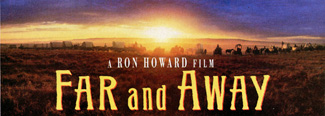 • Go to "Far and Away" Production Notes • Go to Imagine Films Entertainment Presents "Far And Away" |
|
| Go: back - top - back issues - news index Updated 22-01-25 |
